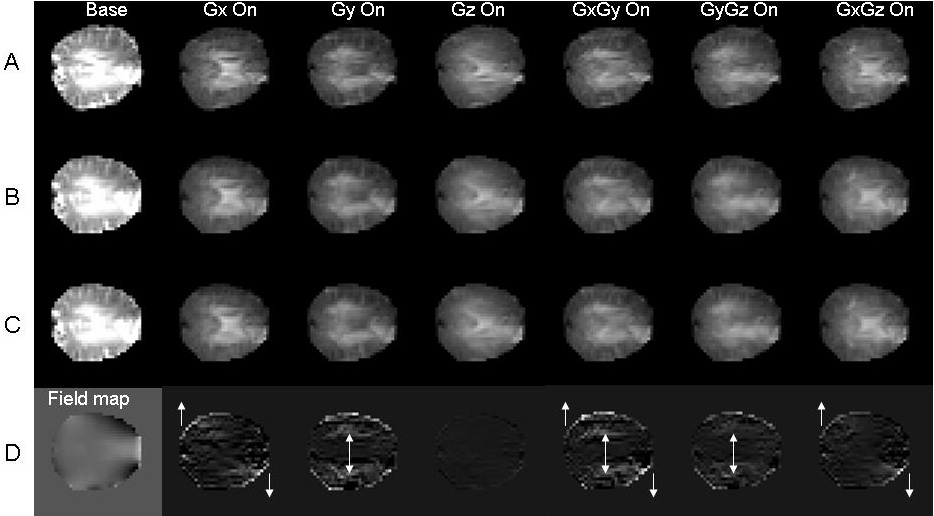Mbirn: B0 and eddy current correction code for diffusion MRI
From NAMIC Wiki
Home < Mbirn: B0 and eddy current correction code for diffusion MRI
- Short Description
- Software tool (excecutable and source code) and recommendations for acquisition protocols to correct distortions in diffusion MR images that are generated by main magnetic field inhomogeneities and eddy current generated from the direction-dependent diffusion encoding gradients.
- Keywords: brain diffusion MRI, distortion correction

Figure: A) DTI dataset containing one base image and six diffusion weighted images. B) DTI dataset after geometric correction using B0 field map only. C) DTI dataset after the full correction procedure using B0 field map and eddy current gradient field maps. D) The difference images between C (full correction) and B (B0 correction only). The corresponding shearing and scaling effects due to eddy currents are indicated by arrows. The first column shows the B0 field map.
- Longer Overview
- Diffusion tensor imaging (DTI) has seen increased usage in clinical and basic science research in the past decade. By assessing the water diffusion anisotropy within the biological tissue, e.g. brain, researchers can infer different fiber structures important for neural pathways. A typical DTI dataset contains at least one base image and six diffusion weighted images along non-collinear encoding directions. The resultant images can then be combined to derive the three principle axes of the diffusion tensor and their respective cross terms, which can in turn be used to compute fraction anisotropy (FA) maps, apparent diffusion coefficient (ADC) maps, and to construct axonal fibers.
- The above operations all assume that DTI images along different encoding directions for the same brain register to each other without spatial distortions. This assumption is general false, as the large diffusion weighting gradients would usually induce eddy currents to generate encoding-direction dependent field gradients, leading to mis-registration within the DTI dataset. Traditional methods for correcting magnetic field induced distortions do not usually take into account these direction-dependent eddy currents unique for DTI, and they are usually time consuming because multiple phase images need to be acquired.
- The theory and implementation of a fast, efficient and effective method to correct for the main field and eddy current-induced direction-dependent distortions for DTI images under a unified frame to facilitate the daily practice of DTI acquisitions have been reported (see References below).
- Here we disseminate the software used in the published work, excecutable and source code.
- Implementation on GE Horizon
- See References below.
- Implementation on Siemens Trio
- The ep2d_difm pulse sequence is an adaptation of the Siemens pulse sequence ep2d_diff. The new sequence maintains the same functionality as its predecessor. Additional functionality was added to allow users to subsequently acquire B0 and/or eddy current multi-echo phase maps from the prescribed slice locations in an additional series.
- A new task card has been added to the console, under Sequence -> Special, which contains the two controls for acquiring field maps. An On/Off widget and a widget for entering the number of echoes to acquire in the EPI pulse train for each phase encode.
- Acquired files are fully compatible to the distributed software for image distortion correction.
- The pulse sequence will be distributed using the standard Siemens C2P scheme. Paperwork for the C2P is in progress. Installation and usage literature will be developed and distributed as per usual for Siemens requirements.
- User Manual
- User Manual The distribution also includes a readme.htm file with use and installation instructions.
- Registration, download and installation
- References
- manuscript Bin Chen; Hua Guo; Allen W. Song. Correction for Direction-Dependent Distortions in Diffusion Tensor Imaging Using Matched Magnetic Field Maps, NeuroImage 30 (2006) 121-129
- Technical Contact
- Please email your comments to: Bin Chen (bc15@duke.edu)
- Acknowledgements